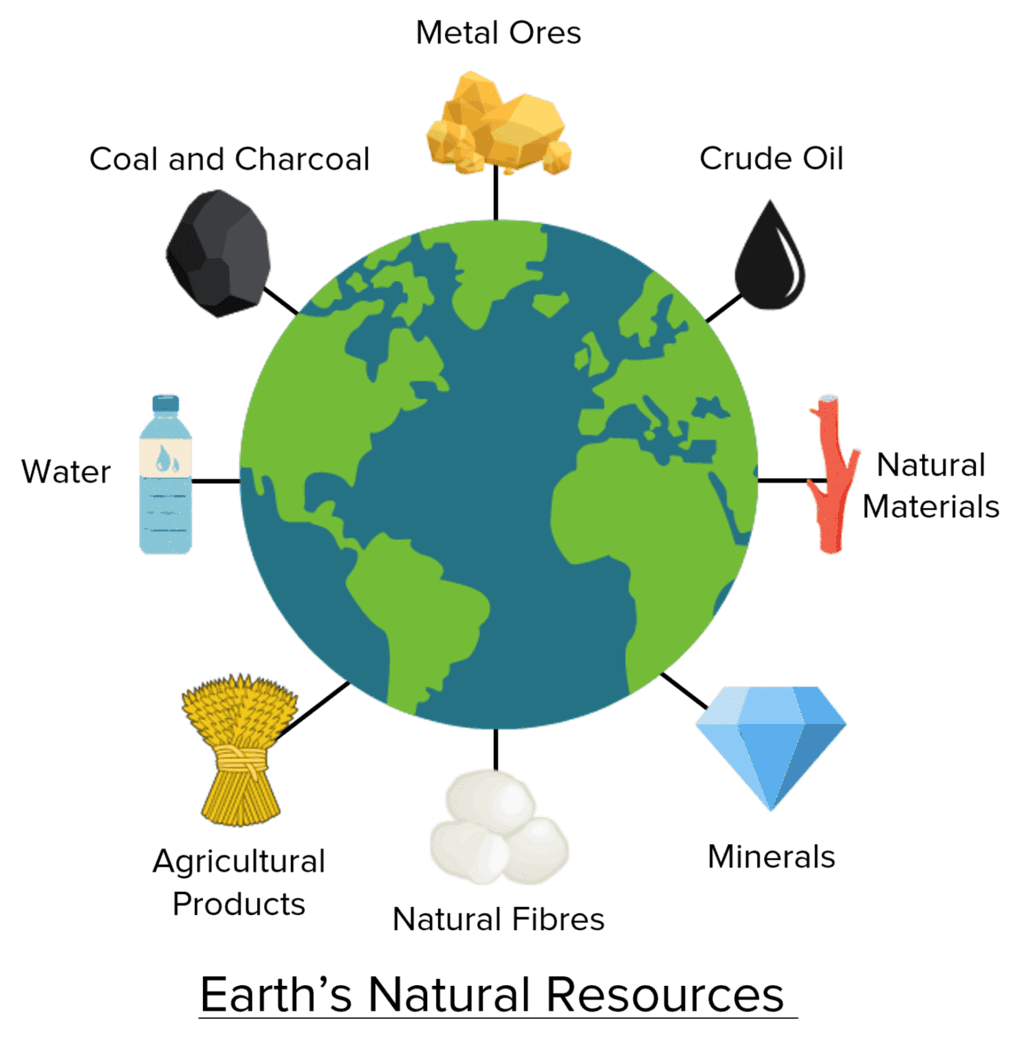Unit Test (Solutions): Natural Resources and Their Use | Social Science Class 8 - New NCERT PDF Download
Time: 1 Hour
M.M.: 30
Attempt all questions.
Question numbers 1 to 4 carry 1 mark each.
Question numbers 5 and 6 carry 2 marks each.
Question numbers 7 to 10 carry 3 marks each.
Question numbers 11 and 12 carry 5 marks each.
Q1. What are natural resources?
(a) Man-made materials
(b) Materials found in nature useful to humans
(c) Plastic products
(d) Manufactured goods
Ans: (b) Materials found in nature useful to humans
Natural resources are materials or substances that occur naturally in the environment and are valuable to humans for various purposes, like water, air, minerals, plants, and animals.
Q2. Name two examples of renewable resources.
Ans: Solar energy and wind energy
Solar energy and wind energy Renewable resources are those that can be naturally replenished in a short time. Solar energy is constantly generated by the sun, and forests can regrow if managed sustainably.
Q3. Are coal and petroleum renewable resources? True or False?
Ans: False
Coal and petroleum are non-renewable resources because they form over millions of years and cannot be replenished quickly enough to keep pace with their use.
Q4. What is meant by “exploitation” of natural resources?
(a) Protecting natural resources
(b) Using and consuming natural resources
(c) Making more natural resources
(d) Ignoring natural resources
Ans: (b) Using and consuming natural resources
Exploitation here means the use or consumption of natural resources for human needs, such as cutting trees for wood or mining minerals.
Q5. Explain why technological accessibility and economic feasibility are important conditions for a natural element to become a resource.
Ans: 1. Technological Accessibility: A natural element requires tools or technology to be extracted or used, such as drilling machines for oil, making it a viable resource.
2. Economic Feasibility: The cost of extraction or use must be affordable, like mining coal economically, to ensure the element is practical for human use.
Q6. What are ecosystem services? Give one example.
Ans: Ecosystem services are benefits humans receive from nature’s functions, like oxygen production or water purification.
Example: A mature tree produces about 275 litres of oxygen daily, supporting human breathing.
Q7. Describe the differences between renewable and non-renewable resources with two examples each.
Ans: 1. Renewable Resources: These regenerate naturally in a short period if managed sustainably, relying on nature’s cycles.
Examples: Solar energy (from sunlight), Forests (timber regrows if replanted).2. Non-Renewable Resources: These form over millions of years and deplete with use, as they cannot be replenished quickly.
Examples: Coal (used for energy), Petroleum (used for fuel).
- Difference: Renewable resources can be sustained through natural cycles, while non-renewable resources are finite and exhaustible.
Q8. How do human activities like industrialization and deforestation affect natural cycles and climate?
Ans: Industrialization, using fossil fuels, emits pollutants, raising global temperatures and causing climate change. Deforestation removes trees that produce oxygen and stabilize soil, leading to biodiversity loss and soil degradation. These disrupt natural restoration and regeneration cycles, such as melting Himalayan glaciers, threatening water security for downstream regions.
Q9. Explain how traditional practices help in sustainable soil management.
Ans: Traditional practices sustain soil by maintaining its fertility naturally. Using cow dung as fertilizer enriches nutrients without harmful chemicals. Mulching retains soil moisture, while multi-cropping and crop rotation diversify nutrients, preventing depletion. These methods, inspired by Vṛkṣāyurveda, support soil organisms and ensure long-term fertility, as demonstrated by Sikkim’s organic farming.
Q10. What is the Natural Resource Curse? Explain how India manages to avoid this issue.
Ans: The Natural Resource Curse occurs when resource-rich countries focus on selling raw materials (e.g., coal) instead of manufacturing products, leading to slow economic growth.
India’s Approach: India avoids this by processing resources into products, like using iron ore for steel or coal for electricity, fostering jobs and growth. Strategic planning and investments in renewables, like Bhadla Solar Park, ensure sustainable resource use and long-term development.
Q11. Discuss the importance of the International Solar Alliance (ISA) and India’s role in promoting renewable energy globally.
Ans: The International Solar Alliance (ISA), launched in 2015 by India and France, promotes solar energy in sunlight-rich countries. Its importance includes:
- Environmental Impact: Reduces reliance on fossil fuels, mitigating climate change.
- Economic Benefits: Creates jobs and affordable electricity, reducing import costs.
- Global Collaboration: Shares technology and resources for solar projects.
India’s Role: As a founding member, India leads with initiatives like Bhadla Solar Park, producing ~15% of Rajasthan’s electricity. It shares expertise and funds solar projects globally, promoting sustainable energy and economic growth.
Q12. Categorize natural resources based on their use, giving examples of essential, material, and energy resources, and describe why each category is important.
Ans: Natural resources are categorized by use into:
Essential for Life: Vital for survival, sourced from nature.
- Examples: Air (breathing), Water (drinking/farming), Food (from soil/organisms).
- Importance: Sustains human life and agriculture.
Resources for Materials: Used for physical objects or aesthetics.
- Examples: Wood (furniture), Marble (sculptures), Gold (jewelry).
- Importance: Supports construction, manufacturing, and cultural expression.
Resources for Energy: Powers industries and modern life.
- Examples: Coal (electricity), Petroleum (fuel), Solar energy (renewable power).
- Importance: Drives economic growth, with renewables ensuring sustainability.
Each category supports human needs, infrastructure, and development, requiring sustainable use for future availability.
|
28 videos|113 docs|7 tests
|
FAQs on Unit Test (Solutions): Natural Resources and Their Use - Social Science Class 8 - New NCERT
| 1. What are natural resources, and why are they important for human life? |  |
| 2. How can natural resources be classified? |  |
| 3. What are some examples of renewable resources and their uses? |  |
| 4. What are the consequences of over-exploitation of natural resources? |  |
| 5. How can individuals contribute to the conservation of natural resources? |  |






















